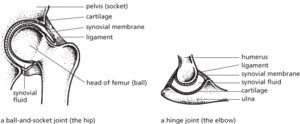The point of contact between two (or more) bones, together with the tissues that surround it. Joints fall into three classes that differ in the degree of freedom of movement they allow: (1) immovable joints, e.g. the sutures between the bones that form the cranium; (2) slightly movable joints, e.g. the symphyses between the vertebrae of the spinal column; and (3) freely movable or synovial joints, e.g. those that occur between the limb bones. Synovial joints include the ball-and-socket joints (between the limbs and the hip and shoulder girdles), which allow movement in all directions; and the hinge joints (e.g. at the knee and elbow), which allow movement in one plane only (see illustration). A synovial joint is bound by ligaments and lined with synovial membrane.

Types of freely movable joint
1. A discrete brittle fracture in a rock along which there has been little or no movement parallel to the plane of fracture, but slight movement normal to it. Fracture may be caused by shrinkage, due to cooling or desiccation, or to the unloading of superincumbent rocks by erosion or tectonism. A group of joints of common origin constitutes a ‘joint set’ and the joints are usually planar and parallel or subparallel in orientation. ‘Joint systems’ comprise two or more joint sets, which are usually arranged systematically with respect to the principal stress axes of regional deformation. Cooling joints (shrinkage joints), such as those which split a rock into long prisms or columns to form ‘columnar joints’, most commonly found in lavas, are due to differential volume changes in cooling and contracting magmas. Unloading joints result from erosional unloading of the crust and form flat-lying, sheet-like joint sets, e.g. those found in granitic rocks.
2. See voids, types of.
A crack in a rock without any clear sign of movement either side of the joint.
- cardinality quantifier
- cardinal number
- cardinal septum
- cardinal tooth
- cardinal utility
- cardinal virtues
- cardioid
- cardioid microphone
- cardiovascular centre
- cardiovascular system
- card not present
- card punch
- card reader
- Cardwell, Edward, Viscount (1813–86)
- care
- career average scheme
- caret
- Carey, Duane Gene (1957– )
- Carey–Foster bridge
- cargo
- cargo bay
- Caribbean Community and Common Market
- Caribbean current
- Caribbean Plate
- caribou